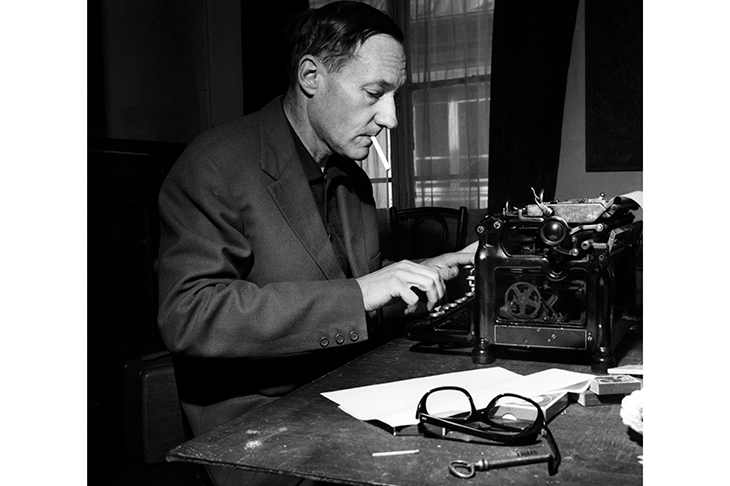William Burroughs was introduced to a British readership in November 1963, and the welcome he received was ‘UGH…’ The headline stood guard over a review in the Times Literary Supplement of Dead Fingers Talk, the first legally obtainable book by Burroughs to be offered to the public in this country. Included in the round-up was a trilogy of novels issued in previous years by the Olympia Press in Paris: The Naked Lunch (1959), The Soft Machine (1961) and The Ticket That Exploded (1962). The three had been compressed, disassembled and rearranged in selected parts by Burroughs himself to create Dead Fingers Talk. The book was launched as a pilot fish by John Calder into a world in which the Lady Chatterley trial was a recent memory and the Lord Chamberlain still had a say in what appeared on the British stage. Could Burroughs swim safely into the mainstream?
The ‘UGH…’ review was anonymous, but it is now well known that its author was John Willett, the deputy editor of the TLS and a translator of Brecht. Burroughs’s novels, he noted, had already attracted ‘the respectful admiration of one or two half-stupified critics’, apparently excited by their outlaw status:
Now the author himself has fished out an assortment of lumps from all three, stirring the mixture and topping it up to make a fourth, slightly more hygienic bucketful which can be cast before us swine.

In his introduction to this new edition of Dead Fingers Talk, Oliver Harris, who probably knows more about Burroughs than anyone alive, calls it ‘a book gone missing in the Burroughs oeuvre’. For half a century it existed ‘more as a title flickering in and out of footnotes than as a work that anybody actually read’. The reason is simple: Burroughs enthusiasts were soon able to turn to the originals. Calder published The Naked Lunch in 1964, and Grove Press brought it out in the US (lacking the definite article) two years later. The other novels followed. Why resort to ‘an assortment of lumps’?
The opening of Dead Fingers Talk is a memorable one: ‘I can feel the heat closing in, feel them out there making their moves, setting up their devil doll stool pigeons…’ It is also the opening of The Naked Lunch. The final section of The Naked Lunch,a tour de force featuring the detective-
novel cops Hauser and O’Brien and the cornered junkie Bill Lee — a fictional version of the author — is here moved up front to sit as the conclusion to chapter one. The second chapter comes straight from The Ticket That Exploded, while the third is drawn from The Soft Machine. Both are cut-up novels, whereas The Naked Lunch is what the author called ‘straight narrative’. For dedicated Burroughsians there is the opportunity to see how chunks of The Naked Lunch read when folded in with the other texts.
The novelty recurs throughout Dead Fingers Talk, and Harris makes much of it in his 40-page introduction. He has immersed himself in the various typescripts and manuscripts, and emerged to claim that ‘this was a much more complex and active process’ than merely making selections for an anthology. While rearranging, Burroughs was also rewriting. Even so, Harris estimates that of the 69,000 words of Dead Fingers Talk a maximum of 1,500 ‘could be called new’.
The ‘UGH…’ review prompted a correspondence in the TLS which lasted into 1964. Anthony Burgess, Michael Moorcock, Calder and finally Burroughs himself (soon to be resident in Mayfair) all pitched in. Norman Mailer had already said of Burroughs that he was ‘the only American novelist living today who may conceivably be possessed by genius’. Burgess proclaimed him ‘the first original since Joyce’.
Testifying for the other side, Edith Sitwell made it known that she did not wish ‘to spend the rest of my life with my nose nailed to other people’s lavatories’. She had a point:
Currents of movement from the two bodies stirred stagnant odor pools; atrophied boy-smell of dusty locker rooms, swimming pool chlorine, dried semen. Other smells curled through pink convolutions, touching unknown doors.
But Mailer had a point, too. This well-produced, gently priced edition of Dead Fingers Talk is worth having for the introduction alone, together with the reproduction of the original jacket. It was designed by Burroughs, and shows a white-out image of his own four-and-a-half-fingered left hand. For all his dizzying knowledge, however, Harris fails to persuade me that the book stands as a separate novel, except in the sense that, as a sequence of cut-ups from the world’s most resourceful razor artist, the assemblage naturally assumes a unique status.
Burroughs has been called a writer of ‘good bits’, and Harris is correct to insist that he is much more. There are,nevertheless, plenty of good bits in Dead Fingers Talk. Those who insist on holding their noses on the way past are avoiding the stink but missing a lot of fun, and neglecting one of the true originals of 20th-century literature.






Comments